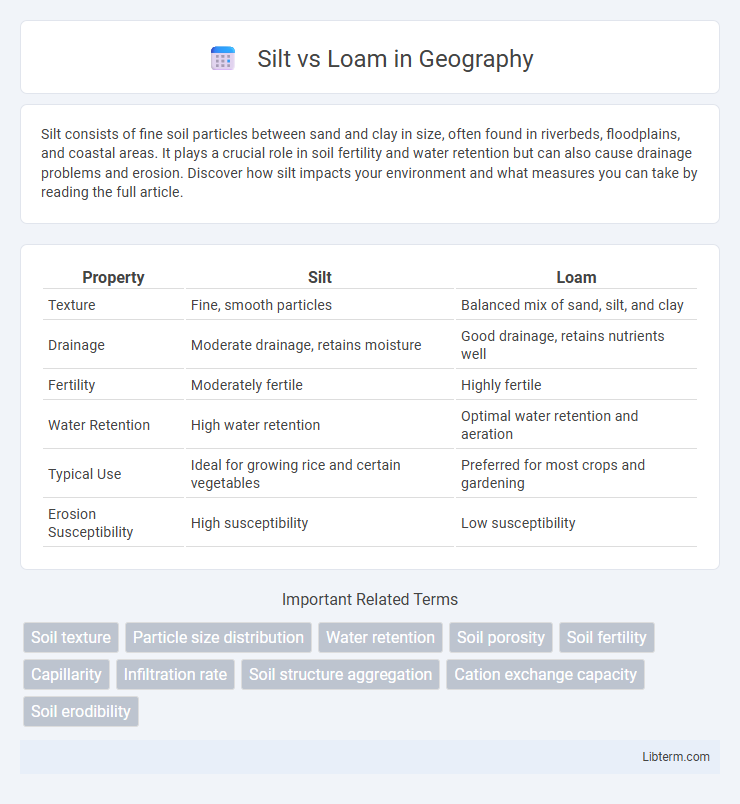Silt consists of fine soil particles between sand and clay in size, often found in riverbeds, floodplains, and coastal areas. It plays a crucial role in soil fertility and water retention but can also cause drainage problems and erosion. Discover how silt impacts your environment and what measures you can take by reading the full article.
Table of Comparison
| Property | Silt | Loam |
|---|---|---|
| Texture | Fine, smooth particles | Balanced mix of sand, silt, and clay |
| Drainage | Moderate drainage, retains moisture | Good drainage, retains nutrients well |
| Fertility | Moderately fertile | Highly fertile |
| Water Retention | High water retention | Optimal water retention and aeration |
| Typical Use | Ideal for growing rice and certain vegetables | Preferred for most crops and gardening |
| Erosion Susceptibility | High susceptibility | Low susceptibility |
Introduction to Silt and Loam
Silt and loam are distinct soil types crucial for agriculture and gardening, each with unique physical properties influencing water retention and nutrient availability. Silt consists primarily of fine particles, smaller than sand but larger than clay, resulting in smooth texture and moderate fertility. Loam is a balanced mixture of sand, silt, and clay, prized for its well-draining structure and rich nutrient content, making it ideal for most plants.
Defining Silt: Properties and Composition
Silt is a fine-grained soil particle ranging from 0.002 to 0.05 mm in diameter, composed mainly of mineral particles derived from weathered rocks, typically quartz and feldspar. Its properties include a smooth texture, moderate water retention, and poor nutrient content compared to loam, making it prone to compaction and reduced aeration. Silt's composition and particle size affect soil drainage and fertility, distinguishing it from loam soils that have balanced proportions of sand, silt, and clay for optimal agricultural use.
Loam Soil Explained: Structure and Characteristics
Loam soil is a balanced mixture of sand, silt, and clay, typically containing about 40% sand, 40% silt, and 20% clay, which creates an ideal structure for optimal drainage and nutrient retention. Its granular texture allows for excellent aeration while maintaining moisture, making it highly fertile and ideal for a wide range of plants. The structure of loam supports healthy root development and microbial activity, promoting robust plant growth compared to finer silt soils that tend to retain excessive moisture and reduce aeration.
Texture Differences: Silt vs Loam
Silt has a smooth, floury texture that feels soft and powdery when dry, while loam contains a balanced mixture of sand, silt, and clay, resulting in a crumbly and slightly gritty texture. Silt particles are finer than sand but coarser than clay, enhancing moisture retention without heavy compaction common in clay soils. Loam's varied particle sizes provide excellent aeration and drainage, making it ideal for plant growth and root development.
Water Retention and Drainage Comparison
Loam soils offer a balanced water retention and drainage capacity due to their mixed composition of sand, silt, and clay, allowing plants to access moisture while preventing waterlogging. Silt soils have finer particles that retain water more effectively than sand but can cause slower drainage, leading to potential root saturation. Optimal plant growth occurs in loam because it maintains adequate moisture levels without compromising aeration or causing excessive water accumulation.
Nutrient Content: Silt vs Loam Soils
Loam soils contain a balanced mixture of sand, silt, and clay, providing higher nutrient retention and better fertility compared to silt soils, which are predominantly composed of fine particles with moderate nutrient-holding capacity. Silt soils tend to have good moisture retention but lower organic matter content, resulting in fewer available nutrients for plants. The superior nutrient availability in loam supports healthier plant growth and higher agricultural productivity.
Suitability for Plant Growth
Loam soil, composed of balanced proportions of sand, silt, and clay, provides optimal drainage, nutrient retention, and aeration, making it highly suitable for diverse plant growth. Silt soil contains finer particles than sand but can compact easily, retaining water and nutrients well but risking poor root oxygenation. While loam supports robust root development and healthy plants, silt requires careful management to prevent waterlogging and to ensure adequate soil structure for optimal growth.
Agricultural Uses of Silt and Loam
Silt soil, with its fine texture and good water retention, is ideal for growing root crops and vegetables that require consistent moisture, while loam soil, a balanced mixture of sand, silt, and clay, is highly valued in agriculture for its excellent drainage and nutrient-holding capacity, supporting a wide variety of crops including fruits, grains, and legumes. Loam's aeration and fertility make it optimal for sustainable farming practices, promoting healthy root development and higher crop yields. Silt's ability to hold nutrients and moisture benefits irrigated fields, but its susceptibility to compaction requires careful management in agriculture.
Pros and Cons of Silt and Loam Soils
Silt soil retains moisture efficiently and has high fertility, making it ideal for crops requiring consistent water, but its fine particles cause poor drainage and susceptibility to compaction. Loam soil offers a balanced mix of sand, silt, and clay, providing excellent drainage, nutrient availability, and aeration, which supports diverse plant growth; however, it may require frequent replenishment of organic matter to maintain fertility. While silt excels in moisture retention, loam's structure reduces erosion risk and improves root penetration, offering a more versatile medium for gardening and agriculture.
Choosing the Right Soil: Silt or Loam?
Choosing the right soil depends on your specific gardening needs and plant types; silt soil is rich in nutrients and retains moisture well but can become compacted and poorly drained. Loam soil offers an ideal balance of sand, silt, and clay, providing excellent drainage, aeration, and fertility, making it suitable for most plants. Consider loam for versatile gardening applications, while silt is preferable for moisture-loving plants in lower-traffic areas.
Silt Infographic

 libterm.com
libterm.com